If you’re looking to get a guitar amp, then you’re in luck because after much research, we have updated our Top 10 Guitar Amps list for 2016.

This page is sponsored by Sweetwater so you can click through to get the full specifications, the latest price, and purchase any of the Amps stocked by Sweetwater that we have recommended.
Guitar amplifiers influence guitar tone in a very big way, as exemplified by how the overdriven amplifier changed the musical landscape in the past, which paved the way to modern blues, rock, metal and other modern guitar styles that we now enjoy. So don’t take your quest for a guitar amp lightly, it deserves proper research, dedication and investment.
Choosing the right guitar amp for your musical style and budget can be a daunting with the many options that are currently available in the market. So we at GuitarSite researched what people buy and what they want to buy, we also took note of what guitarists rate highly in their reviews and comments, along with artist recommendations – all of which helped us come up with this list of 10 great amps updated for 2016.
Things to Consider when buying a Guitar Amp
Tube vs Solid State
Tube amps are generally more sought after by pros and users alike, thanks to their smooth tone and extended harmonic range. However, the downside are the higher price and maintenance requirements. Some also complain of inconsistency between tube amps of the same make, which can be good if you’re looking for a more personal sound. Solid State amps on the other hand are more consistent and affordable, but generally lack the warmth and feel of tube amps. Solid state amps are preferred by guitarists who prefer to get their overdriven sound via pedals, or want clean and transparent tones.
Head vs Combo
Combo amps have speakers built into the unit, they continue to be the industry favorite because of their simplicity. Amp heads allow for more flexibility in terms of choosing your own speakers, ideal for those who want more control over their sound. Since they don’t have speakers built-into them, amp heads are lighter and more portable.
Volume/Output Power
You’ll want a guitar amp that can fill the venues that you play in, especially if you’re not plugging your amp or guitar straight in to a PA. The rule is simple, the more powerful the amp, the more space it can cover. The downside of having an amp with too much power is that you can’t get them to sound good at lower volumes, so either you use a guitar amp attenuator, or get a smaller amp that saturates at lower volume levels.
Voicing
Different amps have different voicings, and this is going to be more obvious as your guitar experience piles up. To pick the amp that matches the voicing that you prefer, you’ll have to research on the amps that you’re favorite guitar player uses – and get the ones that sound close to them. Thanks to digital sound processing, many modern amplifiers are no longer limited to just a few voicings, you should look for these types of amps if you are looking for sonic versatility.
EQ and Tone Shaping
Amps with more tone shaping options allow you to customize your sound better, at the cost of more time spent on tweaking parameters. Some amps, especially old tube ones, have limited EQ controls, so you’ll need to have a rack or pedal EQ to personalize your sound.
Portability
Since not all of us can afford a team of roadies to carry our amps and speaker cabinets for us, portability is an important consideration. If the amp you end up liking is too bulky for your small venue gigs, then you should look for a smaller and more portable alternative. Thankfully, most manufacturers have extensive guitar amp lineups that cover everything from small to big.
| Num | Link to Sweetwater | Link to Sweetwater | Overview | Link to Description |
|---|---|---|---|---|
1.
| 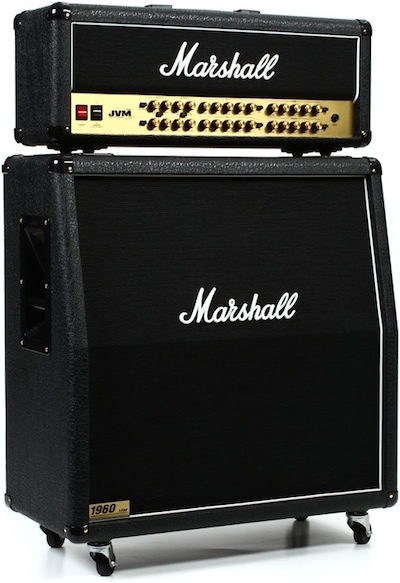 |
Marshall JVM410H Amp Head
| Marshall is one of the most iconic guitar amp brands in rock history, and their flagship model, the JVM410H, is their most versatile yet, offering tones that cover everything from classic cleans to modern high-gain. More Marshall Amps. | See our Marshall JVM410H review below |
2.
| 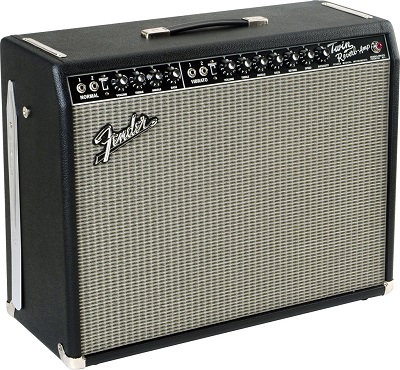 |
Fender 65 Twin Reverb
| In 1965 Fender hit upon the idea of adding spring reverb to their leading tube amp and the result was so popular with famous guitarists that it has remained one of their leading amps to this day. More Fender Amps. | Fender ’65 Twin Reverb review below |
3.
| 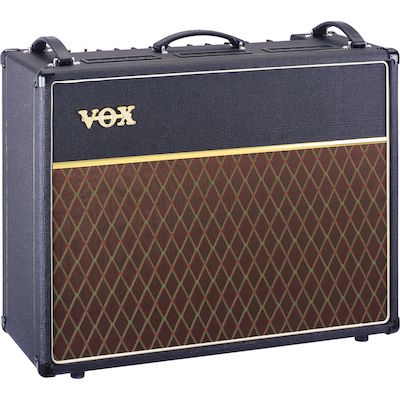 |
Vox AC30C2X
| Although it’s pretty much impossible to get an original AC30 today, the modern Vox AC30C2X gets you real close at a lower price point, with the added bonus of having footswitchable reverb and tremolo effects. More Vox Amps. | See our full Vox AC30C2X review below |
4.
| 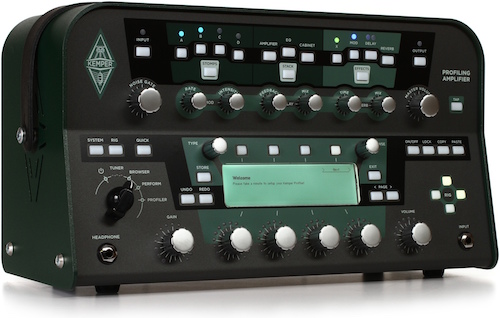 |
Kemper Profiler PowerHead
| The Kemper Profiler has now become industry standard, used by professional artists from various musical backgrounds. The Profiler PowerHead bundles this innovative technology with a built-in poweramp that can drive speaker cabinets. More Kemper Products. | Our Kemper Profiler PowerHead review below |
5.
|
Peavey 6505+
| Peavey has a long track record of building guitar amps that compare favorably to their high-end counterparts while retaining a mid-range price. The 6505+, previously known as the 5150 when it was Eddie Van Halen’s signature amp, is one of Peavey’s leading amps in this regard and also owes its heritage to Soldano SLO amps. More Peavey Amps. | See our extended 6505+ review below | |
6.
| 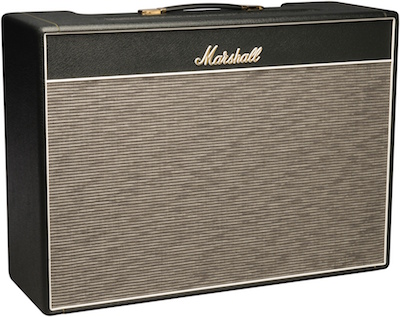 |
Marshall 1962 Bluesbreaker
| Marshall’s iconic “Bluesbreaker” combo amplifier secures a spot on this list with its current production line model, carrying over the same 30-watt all-tube design and vintage blues rock tone made famous by Eric Clapton. More Marshall Amps. | See our full Marshall 1962 Bluesbreaker review below |
7.
| 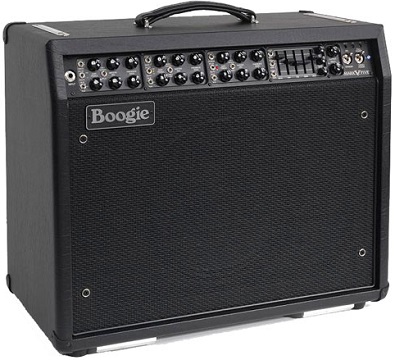 |
Mesa/Boogie Mark V
| The Mark V is a special guitar amp because it uses patented technology to deliver 9 different tube-amp sounds without using digital modeling. It also has a built-in attenuator so you can get that cranked tube sound without having to be too loud. More Mesa Boogie Amps. | Extended Mark V review below |
8.
| 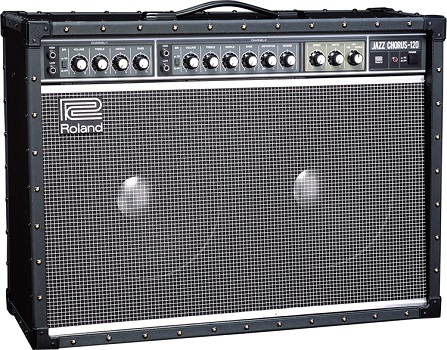 |
Roland JC-120 Jazz Chorus
| If you’re looking for a sparkling clean solid-state sound then a Roland Jazz Chorus should be at the top of your list. It has built-in stereo chorus, vibrato and reverb as well as a stereo effects loop so you can also get great distortion and overdrive with your favorite effects units. More Roland Amps. | See our JC-120 review below |
9.
| 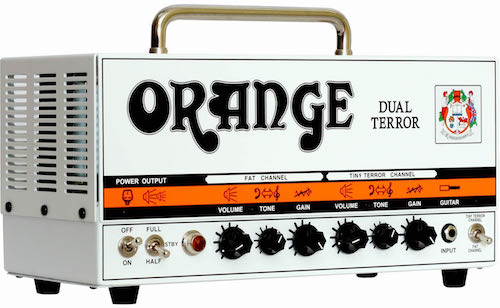 |
Orange Dual Terror
| Orange single-handedly started the tiny lunchbox style tube amp craze, and the Dual Terror is one of the most popular in their line up, thanks to its 2-channel design and switchable 30W, 15W and 7W operation. More Orange Amps. | See our Orange Dual Terror review below |
10.
| 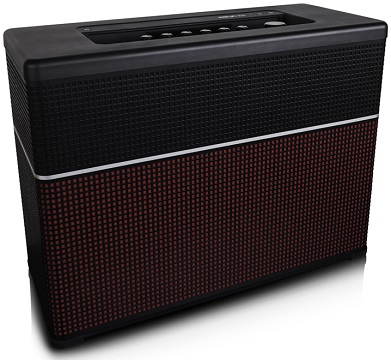 |
Line 6 AMPLIFi 150
| Line 6 continues to stretch amplifier design with AMPLIFi, a compact amplifier that can double as a home HI-Fi sound system, complete with bluetooth streaming, direct recording and the latest in digital amp and effects modeling. More Line 6 Amps. | See our AMPLIFi 150 review below |
Top 10 Amps – Extended Reviews
1. Marshall JVM410H Head
Marshall amps have come a long way, from being a modified Fender Bassman clone to becoming THE amp synonymous with rock guitar. Their logo continues to mark the back-line of today’s guitar greats including Eric Johnson, Joe Satriani, Slash, Angus Young, Dave Mustaine, Joe Bonamassa and many more! I mean, let’s face it, if you’ve been playing rock guitar for a while, you’ve probably dreamt of playing your magnificent riffs to a sold out arena, specifically with a wall of Marshall stacks at your back.
The JCM800 and 1959 Super Lead 100 a.k.a. “Plexi” are their most popular amp heads, both of which are still in production due to high demand. However this list deserves what the brand considers as their “flagship” amplifier, the JVM410H, a versatile all-tube amp that lets you switch between multiple Marshall circuits, from the old JTM45 to modern high-gain.

At first glance, the front panel of the JVM410H amp head can be a bit intimidating with its 28 controls and 8 switches. But further inspection will show that the controls are intuitively laid out, and can easily be broken down to controlling the amp’s four independent channels: clean, crunch, OD1 and OD2.
Note that the four channels come with three modes that give each channel three distinct voices, so you get a total of 12 distinct Marshall tones in one package! With the JVM410H, you get the popular Plexi and JCM800 tones, as well as great sounding clean tones and modern high-gain! Other features include studio-quality digital reverbs and EQ for each channel, and two master volumes.
Completing this famous halfstack configuration is the Marshall 1960A Angled Cabinet ($949.99) with four 12″ speakers. Although the design has stayed relatively the same, this cabinet continues to be used on stages world over, a testament to its great sound and reliability. This feature packed 100W amp and halfstack is probably the last amp that you’ll ever need. Note that you can use a guitar amp attenuator if you want to drive the amp’s powerful ECC38 and EL34 tubes at lower volumes. Manufacturer: Marshall Amps | Get the latest price & reviews at Sweetwater.com
2. Fender ’65 Twin Reverb
In 1952, before the first Stratocaster even hit the market, Fender released what has become the epitome of guitar amplifiers – the “Twin”. This amp went on to be the amp of choice for the Beatles, Keith Richards, Eric Clapton, and Jimi Hendrix from 1965 to 1966.

In 1963, Fender upgraded the Twin by adding a spring reverb. The Twin was then replaced by the Twin Reverb, which then became the go-to amplifier for guitarists who are looking for the best clean tone. Today, the ’65 Twin Reverb re-issue continues this legacy of providing clean and unhindered tone.
I remember the first time I plugged into a Twin Reverb, it was like hearing my Strat for the first time – all the nuances of my playing came alive! After trying one, I found myself craving for clean and organic straight-to-amp sounds, that resulted in me simplifying my setup.
The current ’65 Twin Reverb features four 6L6 Groove Tubes for the output section, four 12AX7 and 12AT7 preamp tubes. It drives two 12″ 8-ohm Jensen C-12K speakers. No overdrive on this baby, but it works really well with dirt and fuzz boxes.
If you have a single-coil equipped guitar, then you should at least try the Twin Reverb before you decide on your next amp. Manufacturer: Fender | Get the latest price & reviews at Sweetwater.com
3. Vox AC30C2X
For almost six decades now, the Vox AC30 continues to captivate guitarists and listeners alike with its elegant appeal and jangly tone. And as expected, we can’t talk about best guitar amplifiers without mentioning this iconic amp.

Unfortunately, vintage AC30 and high-end replicas come with price tags that may not be practical for many guitar players. Thankfully, Vox released the AC30C2X, which provides the same classic look and sound, at a more accessible price and with some nifty modern additions to boot.
The AC30C2X follows after the same all-tube design of the original, with three 12AX7 preamp tubes and four EL84 power tubes that gives this amp that unmistakable British invasion flavor. The amplifier section drives dual 12″ Celestion Alnico Blue speakers which are especially designed to complement the bright and chimey sound expected from the amplifier.
Like the original, this amp comes with two channels, Normal and Top Boost, of which the Normal channel would probably get the most use because of its pedal-friendly clean sound. The Top Boost will give you classic overdriven tones that many users and experts have found to be similar to vintage specimens. Other features include independent volume controls for each channel, tone cut knob for dampening highs, a dedicated overdrive gain knob, and a middle frequency knob for extra tone shaping. The added reverb and tremolo effects are also note worthy additions to the original design, giving you more value for your money. Manufacturer: Vox Amps | Get the latest Vox AC30C2X price & reviews at Sweetwater.com
4. Kemper Profiler PowerHead
While there’s really no substitute to the feel and vibe of a genuine tube amp, digital sound processing continues to get dangerously close – to the point that it has become hard to identify which is which in a blind test. Kemper took this technology a step further by developing a way to conveniently “profile” or mimic the sound of any amp, and do so with just a few button switches! The Profiler’s realism and versatility continue to impress professionals worldwide, as evidenced by the many artists that have been spotted using this miracle lunch box.

With the PowerHead, you get the same innovative profiling technology plus a 600 Watt power amplifier packed inside the same compact and lightweight lunchbox profile. This effectively makes the Kemper Profiler a true amplifier that can drive speaker cabinets, ideal for guitarists who prefer a real speaker cabinet that moves the air – over going straight to console and just using emulated cabinets. Just don’t forget to turn off the cab simulation feature when using the PowerHead with an actual guitar speaker cabinet.
With the PowerHead, you get to utilize a wide selection of profiled amplifiers, from the ones profiled by Kemper themselves, to others that were profiled by users. This is like carrying multiple tube amps, except you’re holding a small lunch box, and you can switch between amps quickly and conveniently. And it’s not just about quantity either, because majority of reviewers were easily impressed by the sound quality and incredible realism of each profiled amplifier.
While the Kemper Profiler PowerHead commands a premium price tag, considering its capabilities and quality – it is easily the most practical option for professionals and tone connoisseurs. Manufacturer: Kemper Amps | Get the latest Kemper Profiler PowerHead price & reviews at Sweetwater.com
5. Peavey 6505 Plus
This amp was first released in 1992 as the 5150, Eddie Van Halen’s signature tube amp. It is said to be derived from the Soldano SLO, but it has grown to be a different amp with its own unique tone. It soon became well known for its high-gain overdrive channel, which crossed over from rock to metal, inspiring the current down-tuned riff-driven guitar playing prevalent in this genre.
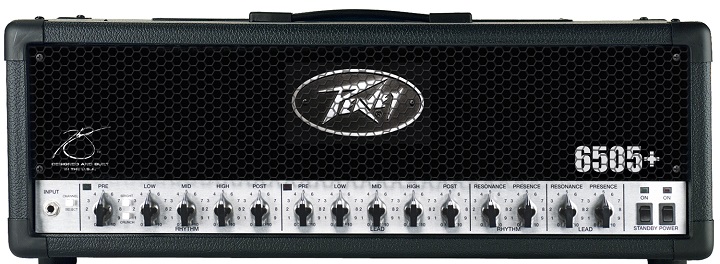
Unfortunately, Eddie parted ways with Peavey in 2004 and brought the 5150 name with him to his new EVH company. But because of the amp’s popularity, the original 5150’s story did not end there, Peavey decided to rebadge it as a non-signature model and continue production. The label 6505 came about in celebration of Peavey’s 40th anniversary (’65-’05).
The 6505+ continues the legacy of the original 5150, providing more gain than you’ll ever need at a reasonable price. It features six 12AX7 preamp and four 6L6GC power amp tubes that are capable of providing modern guitar players with the chunkiest riffs and mix cutting leads.
Its tone shaping features will let you replicate the tone of many modern metal players, with each channel featuring three-band EQ, Pre Gain and Post Gain controls. The Resonance and Presence controls for each channel helped the amp keep up with the ever lower down-tuned riffs of today’s metal scene.
Touring guitarists like Robb Flynn, Ted Nugent and many more, vouch for the amp’s reliability. If you are into metal and are looking for your first proper amp head, the 120 watt 6505+ is a no-brainer. Manufacturer: Peavey
6. Marshall 1962 Bluesbreaker
Thanks to Eric Clapton’s brilliant guitar work in John Mayall & the Bluesbreakers, many became interested in picking up the guitar – and getting the same gear that Clapton used. This helped build the reputation of Marshall, who was the one who built the combo amp that Eric used on their recordings and performances – which eventually got the nickname “Bluesbreaker”. Up to this day, the Bluesbreaker tone continues to be sought after, as evidenced by the soaring prices of vintage specimens.

Thankfully, Marshall has brought the Bluesbreaker back in to production, with some improvements to make it more reliable and viable for today’s musicians – and being the iconic amp that it is, it deserves a spot right here. Like the original, the preamp section has three ECC83 preamp tubes, while the output has a pair of 5881 tubes. Even the rectifier section has a GZ34 tube, and all of them are wired much like amps of old. The amp section drives a pair of Celestion G12-M Greenback speakers, resulting in dynamic and singing tones, just like the original.
The obvious use for this amp is to get classic blues and rock tones like Clapton did. And to do just that, you’ll have to drive the amp hard to breaking point, and since the power rating is lower than full stacks, this can be done by the 1962 at a more tolerable level. You can also use a boost pedal in front of the amp, to get the overdrive earlier, and to achieve more modern voicings.
The Marshall 1962 is not just about blues and rock as attested to by expert reviews, who found that it cleans up quite well at lower volume settings. It is also very pedal/rig friendly, in case you are a heavy effect user. Finally, the amp comes with a ECC83 tube driven tremolo circuit that complements the vintage voicing well. If you have the budget, and you’re looking for a true to form blues-rock tube amplifier, then this is your best bet. Manufacturer: Marshall Amps | Get the latest Marshall 1962 Bluesbreaker price & reviews at Sweetwater.com
7. Mesa/Boogie Mark V
While other boutique amp builders go for accurate recreation of vintage sounds or articulate high-gain, Mesa/Boogie aims to tackle it all by pushing the boundaries of guitar amp technology.

Brand founder Randall Smith also started out as a technician who repaired and modified existing amps in the ’60s, in fact the first Boogie amp is a modified Fender Princeton. Prominent players of the era went to him when they wanted to make their amp louder and to add distortion, which was still considered unique at that time.
In 1972, Smith released Mark I, which added an extra tube gain stage to the preamp. It was the first of a series of amps that carried the Mesa/Boogie brand. Artists such as Carlos Santana, John Petrucci, Andy Timmons and many others are known supporters.
Mesa/Boogie Mark V is the latest iteration of the Mark I, featuring all the sounds of the previous versions and other additions. It is literally a collection of boutique quality amplifier circuits packed into a single amp.
It is said that this amp utilizes 9 patented technologies, including a built-in attenuator called Multi-Watt and the ability to switch amp class via the Simul-Class technology. The amp comes with three independent channels with three modes for each channel, giving you a total of 9 tube-amp sounds in one package. A wealth of tone shaping controls are also available, including Mesa/Boogie’s popular 5-band slider EQ.
There’s so much to be said about the amp’s features but the bottom line is that it can give you more tones than you can actually hope to use. And purists can’t complain because it doesn’t use any digital modeling! This amp is well worth checking out, especially if you are tasked to play various musical styles in one sitting. Manufacturer: Mesa/Boogie | Get the latest price & reviews at Sweetwater.com
8. Roland JC-120 Jazz Chorus
In a list dominated by tube driven amps, the “queen of clean” Roland Jazz Chorus easily stands out because it represents the solidstate side. First released by Roland in the mid ’70s, the Jazz Chorus became the amp of choice for guitarists well into the ’80s, providing an affordable and more reliable alternative to the tube amps available in the market at the time.

Behind this straightforward amp are big name guitarists that play a wide variety of styles, including Andy Summers, Pat Metheny, Robert Smith, James Hetfield, Kirk Hammett and Jeff Buckley to name just a few. And now, after more than 30 years, the amp design has remained virtually unchanged. It even influenced many of Roland’s succeeding amp models, including the immensely popular practice amps from the Cube series.
The JC-120 is the loudest of the Jazz Chorus series that is currently available. It is known for producing amazingly clean and sparkling sounds that let your actual guitar tones push through even in big venues.
For some reason, Roland has not updated the built-in distortion found on the amp, the only aspect of the Jazz Chorus that fails to impress. Thankfully, the amp more than makes up for it by being pedal friendly, you can simply use your preferred overdrive or distortion pedal to get the dirt tones that you prefer. It also features a nifty stereo effects loop, so your stereo effects can make full use of the amp’s stereo 12″ speakers.
Complementing the amp’s amazing clean tones, are reverb, vibrato and true stereo chorus effects. And all of its features are packed safely inside its tank tough cabinet. If you are looking for a powerful and reliable clean amp that works great with effects, then you should get the JC-120 Jaz Chorus. Manufacturer: Roland | Get the latest price & reviews at Sweetwater.com
9. Orange Dual Terror Head
If style and personality is ranked high in your list of priorities, then you will find Orange amps appealing. Their amps come with stylish and eccentric looks that make them visually stand out, and this cosmetic appeal is matched by the tones that their amps produce.

One of the biggest contributions of Orange Amps to modern guitar gear technology is the introduction of the Tiny Terror back in 2006. It was the first ever “lunchbox style” tube amp which quickly grew in popularity and has since become its own amp category. The Dual Terror is the most powerful to come out of this line, and as the name implies, it features two channels – one having the same circuit as the original Tiny Terror for clean to blues-rock tone, and the other having extra gain and a more rounded tone called the “Fat” channel.
As expected, it carries over all the other convenient features of the terror series, including the lunchbox handle, compact size, and straightforward tone shaping controls. The Dual Terror is louder and punchier with its 30W power rating, but it can be attenuated to 15W or 7W in case you want to drive the four ECC83/12AX7 preamp tubes and four EL84 output tubes at lower volumes.
In addition to being versatile and compact, this amp is also reasonably priced, making it a serious and practical option for gigging guitarists who are looking for genuine tube tones that they can carry around for recording or for playing line in small to mid-size venues. Manufacturer: Orange Amps | Get the latest price & reviews at Sweetwater.com
10. Line 6 AMPLIFi 150
In 1996, Line 6 took the guitar world by storm when they introduced the first digital modeling amplifier, the AxSys 212. I remember how impressed I was after reading their ad on a guitar magazine that same year. They have since continued improving their amp modeling technology, and their affordable Spider amp series continue to be among the best selling amps in the USA.

After focusing mostly on their floorboard and rack mounted guitar processors over the past few years, Line 6 is back in the amp building race with the innovative multi-purpose amp called the AMPLIFi. By the looks of things, they are going to set the pace yet again, and their competitors will again be forced to follow.
With AMPLIFi, Line 6 expands the functionality of the guitar amp by incorporating hi-fi audio speaker design and modern connectivity. The result is an amp that can double as a wireless multimedia speaker system, thanks to its full range 5-speaker stereo system. This makes buying a new amp easier to justify, since it can be a used for music streaming, among other things.
Like the top selling Spider amp range, AMPLIFi comes with a wide variety of modeled amps and effects. You can choose from over 200 pieces of virtual gear to build your rig, and you can do it all in the comfort of your iPhone or iPad. And like many of today’s guitar processor equipped gear, you can share your settings online or use the virtual rigs of other players, including those of artists. As a plus, when listening to a music track, the accompanying app can recommend matching guitar tones that you can use to play along!
Finally, since AMPLIFi is made by Line 6, the price tag is very reasonable. Even if you already own a great tube amp, the AMPLIFi would still be a very practical addition to your gear, or your living room. Manufacturer: Line 6
So have your say in the comments below and let everyone know what you say should be in the Top 10.
Related Articles:
You might also like to check out our list of the best Guitar Amps for under $500.
You don’t need to lug around a big amp for practicing – check out these Practice Amps.
See which low-cost Tube Amps we recommend.
Check out our round up of the Best Acoustic Guitar Amps!





Thanks for sharing this post, this will help us to choose which one is the best amplifier.
I want to buy an amplifier and this list help me a lot to choose one from this list.
The Amplifi isn’t even a top 10 best Line6 product. Never mind the fact that it is cheaply made and looks like a room humidifier from an early 1980s Las Vegas hotel room. It’s got modeling that is well below the Helix’ level, lacks responsiveness, and is hamstrung unless you stare at your phone every time you fire it up.
I agree with your comment that Helix is better than AMPLIFi (that’s a given), but AMPLIFi is in this list because it is still better (for now) than many of the amps in the market. And while there can be disagreements when it comes to tone and aesthetics, there’s no denying what it brings to the table: modern bluetooth streaming, wireless app control convenience, amp modeling versatility, and value for money.
If you would like to try one ampli from abroad I suggest Amplificazioni Lombardi; it is not famous as Marshall (for example), but it is the choice of some US artists as Bonnie Prince Billy, Howe Gelb, Steve Earle.. and it has a tradition and experience of more than 50 years.
I almost took this list seriously until I seen line 6 on it. Peaveys are crap. Ohh turd nugent plays one nugent sucks. Never understood hy he was ever considered good.
Roland JC-120 Jazz Chorus its ok
I believe that the time of modelling has really arrived. The Full Function Full Range speaker systems and dual processors have just nailed classic tones. I bought an Amplifi and am astounded with the tone.
Where is Harry Joyce?
This list is not credible without a JTM-45, 68 Super Lead, or JCM800. The JVM’s are OK but not a patch on any of these amps.
We did mention two of Marshall’s more popular amps, the Plexi and JCM800. But since everybody already knows about them, we decided to feature Marshall’s flagship amp, the JVM410H, which in our opinion rightly deserves the spot for its impressive sonic flexibility (it can do JCM800 and Plexi tones quite nicely) and value for money.
With the inclusion of the Mesa Boogie, Marshall, Two Rock, etc., you are getting closer to a true list of top amps. I personally play a Matchless HC 30 & would of course suggest it for your list, along with the Reeves Custom 50 & Custom 50 Jimmy, along with the Fargen Olde 800 & of course the venerable Hiwatt.
Thanks for proving a platform where people can communicate their favorites.
Keep On Rocking,
Ian